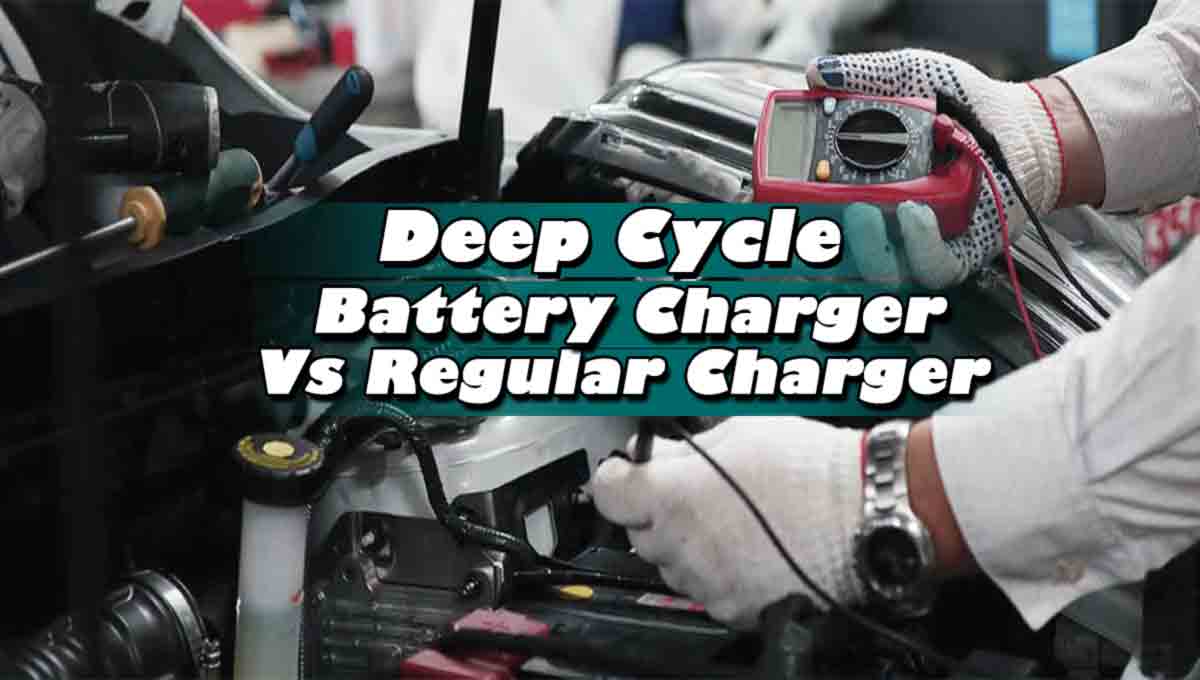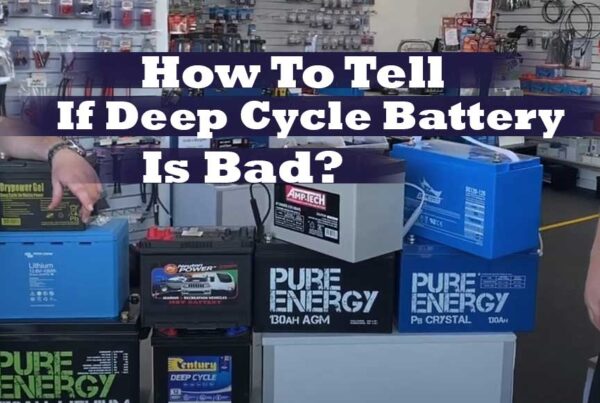From flashlights to smartphones to cars – where don’t you have batteries? When you have a battery, you must have a suitable charger – even for your four-wheelers. But what sort of chargers do those huge batteries need? It may surprise you to learn that the batteries on your car regularly recharge on quick-chargers.
But wait! Haven’t you heard quick-chargers shorten your phone’s battery life? Do they thwart your car’s battery all the same?
Deep cycle chargers claim that regulars do and they have come to solve the problem. But can they really? Let’s learn actually what are the benefits vs loss when the match goes deep cycle battery charger vs regular.
 What does a Deep Cycle Battery mean?
What does a Deep Cycle Battery mean?
Before you learn about the charger, you need to know about the batteries it charges firstly. While battery size ranges from miniscule to massive, the capacity has a lot to define its dimension and worth. Automotive batteries are always heavy both in size and price tag for the same reason.
Belonging to the lead-acid class, deep cycle batteries are capable of being deeply discharged on a regular basis while utilizing its maximum capacity. Efficient deep charging models have an ideal Depth of Discharge (DOD) rate of 50%, while 80% has been reported as maximum.
The cells are designed to undergo lesser degradation due to frequent charging and discharging cycles as opposed to the cranking batteries which give high current bursts instantly to start engines, delivering only a part of their capacity.
Now-a-days lithium-ion batteries have come with the same deep discharging performance, but in smaller sizes and with higher price tags.
Where Do You Use a Deep Discharging Battery?
Are you yet to see a deep charging battery practically? You will come across them where frequent and regular discharging is necessary. Such as in trolling motors, traffic signals, motorized wheelchairs, forklifts, floor sweepers, UPS, electric vehicles, or off-grid electric storages. The thicker plates of these batteries are incapable of delivering peak current, so aren’t used as cranking batteries.
Let’s Compare between Deep Cycle Batteries vs Regular Batteries
The technical differences between deep discharging batteries and regular ones may get you perplexed. Both the batteries use almost the same chemistry, but a significantly different physics. We already have discussed the main point of difference in their action above.
Structure and Size
When we consider the structure of the two, we find the main distinction in the lead plates of the batteries. Deep charging batteries consist of thicker active plates with active paste material of higher density on them and thicker layers to separate the plates – all of this combines to resist corrosion during charging cycles. As a result, the battery lasts longer.
While on the other side, starting batteries are made of numerous thin and light plates. These provide maximum surface area that ensures maximum current output but can disintegrate prematurely from the mechanical stress due to frequent deep discharges.
Starting batteries of the same size weigh lighter than their deep charging counterpart for their lighter and shorter plates placed above a legroom. It allows debris from the electrodes to collect there to protect battery plates from them.
Depth of Discharge
Unlike the deep powering counterparts, cranking L-A batteries are used to start the engines. So, these have to produce a burst of high current within a jiffy to create sparkles igniting the combustion engine. Where the deep ones can discharge up to 80%, each time a starter battery is used, it discharges only 2% to 5% of its DOD. Cranking batteries cannot endure deep discharge and get easily damaged from it.
What does a Deep Cycle Battery Charger signify?
Chargers serve the purpose of recharging the specific kind of batteries they are built for. A deep phase charger charges a battery with a slow and steady current. While a deep charger pushes its charge to its full limit, a regular charger does more like a quick-charger of a smartphone. So, which one should you buy when it comes to deep cycle vs regular battery charger?
Types of Deep Cycle Chargers
1. Basic Chargers
Basic chargers simply restore the power in your battery. These are widely used and have the universal fit capability for a wider variety of batteries – AGMs, marine batteries, gel batteries, etc.
2.Restoration Chargers
These are used to mainly treat sulfation and remove contaminants built up around the battery’s plates. Such models are mainly found in industrial settings.
What happens when Deep Cycle Battery Chargers vs Regular Chargers are in the match?
Unless you have bought the multi-function chargers with many charging modes to choose from – a deep discharging battery cannot endure charging with regular ones. It will produce overheating and can lead to total cell damage. And for the regular batteries, it takes too long to get them charged with a deep phase charger. So, you should wisely make a choice between the two.
The apparent comparison between a deep charging battery charger and a standard battery charger can be enlisted as follows :
Regular Chargers Are Speedy but not Risk-free
You know what deep recharge cycles mean by now. Deep cycles need a long period of time to both charge and discharge. In most cases, deep charging your battery takes at least two days. Moreover, the charging current is slow – below 2 amps on average. But the charging is done to the optimum level possible.
On the other hand, a regular charger acts more like offering an instant solution. It charges your battery within shorter periods of time – a day or less, with a current of 10 to 15 amps. Fast charging may be unavoidable to kick start the engine, but it surely hampers your battery because it doesn’t allow additional time for the acid to penetrate the plates in the battery.
Deep Chargers are Expensive
The price tag is the last but the most practical factor to consider whenever we buy anything. Otherwise, all those planning would go in vain. Regular chargers are as cheap as 25 USD and available everywhere.
But the deep cycling chargers are rare to find and tougher to buy. The cheapest option weaves around 100 USD.
Which one to choose between Float Chargers and Trickle Chargers?
Regular chargers have the ‘float charging’ mechanism which makes it shut down once your battery is full, and start the charging phase when it is low. This feature is crucial to prevent overcharging and thus enhance battery life.
On the opposite, deep chargers don’t kick in unless your battery is fully down. Moreover, they don’t shut down on their own. A low but steady stream of electricity continues to flow to your battery unless you plug it off.
Can They Overcharge the Battery?
As stated above, regular chargers shut down and don’t overcharge your cells. The deep penetrating chargers just do the opposite. If you are a forgetful guy just like me, you will be losing your battery life as you keep the charger plugged in
Which One Would Overheat Your Battery?
Heat slowly kills your battery – no doubt. Deep chargers however cause this problem. Therefore, manufacturers suggest letting it rest before putting it into action again after charging.
On the contrary, regular chargers have been developed over decades and have this drawback to its minimum. It can charge the battery instantly and the battery can run into work.
6. Deep Chargers Bring More Battery Life
A deep discharge charger charges the battery to its full capacity and the battery can discharge to its maximum. So, there would be very little loss of the battery’s life expectancy, and a higher value for your money would be ensured.
On the other hand, regular charging is fast and causes sulfate debris to start gathering on the plate over time. As a result, the battery life gets reduced in the process.
Wait, Don’t Leave
You must assess quite a lot of factors before you decide between the two. Keep in mind that an option may theoretically sound excellent but may not prove useful for you in reality. So keep on asking yourself these questions – Why do I need this charger? Which batteries am I gonna charge? Will the battery need fast charging or deep charging? Etc. Hopefully matching your answers with the guideline above you leave you to just the right choice.



 What does a Deep Cycle Battery mean?
What does a Deep Cycle Battery mean?



